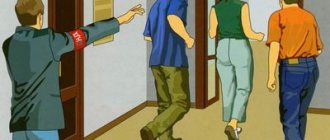Examples in pictures with explanations
The decoding of signal objects is as follows:
- Prohibiting:
They reflect life- and health-threatening factors. These include, for example, clamping. Employees who do not comply with these guidelines risk receiving disciplinary action or being fired for gross misconduct. - Index fingers:
Help staff navigate inside the enterprise. Especially useful for beginners or students and employees of other organizations. - Warning:
Serve as an indication of particularly dangerous factors that may arise during the performance of the employee’s job duties. They also mean that it is unsafe to work here. - Prescriptive:
The most common information signs that contain information about the use of equipment and protective clothing in a specific area.
Responsibility for the absence of signs
The management of the enterprise must take care of the safety of personnel, therefore the presence of special signs in hazardous areas is mandatory. If there are none at all, or if their placement does not meet the standards, the head of the organization will face a large fine and an order to eliminate the identified violations.
The official responsible for safety precautions must not only ensure that hazardous areas are closed, but also instruct employees on labor safety standards. Information about the briefing is entered into the log of familiarization with labor safety instructions; this document records the time, type of briefing, and the fact of the training is confirmed by the signatures of the person in charge and employees.
If you find an error, please select a piece of text and press Ctrl+Enter.
Why are occupational safety signs needed?
Dear readers! The article talks about typical ways to resolve legal issues, but each case is individual. If you want to find out how to solve your particular problem , contact a consultant:
8 (800) 700 95 53
APPLICATIONS AND CALLS ARE ACCEPTED 24/7 and 7 days a week.
It's fast and FREE !
The manufacturing rules, as well as their installation, are prescribed in GOST 12.4.026-2015.
They must warn workers of the danger and indicate actions to take during an emergency.
Thanks to them, employees can learn the following information:
- An area where caution and extra attention should be exercised.
- Types of occupational hazards that may threaten an employee.
Color design of signs
According to GOST standards, occupational safety signs have strictly regulated colors. Each type of marking has a special signal color, which is recognized as the most favorable for visual perception. All types of main signs are depicted on a bright colored background, the symbols are applied to them in black or white for maximum contrast.
Each color has its own use and purpose:
- Red is the most visible color, so it is used to emphasize danger. It is used for prohibition signs that should attract increased attention.
- Yellow is a warning color. Yellow signs with black symbols are used to indicate a possible threat.
- Green is considered the most benevolent color, so it is used for medical and evacuation symbols.
- Blue color is used for instructions and instructions.
GOST specifies in detail which color is assigned to each group of signs. The external design is also prescribed for the most accessible and uniform presentation of information.
Kinds
There are a huge number of these objects. Their specificity depends on:
- Appointments.
- Transmitted information.
- Colors.
- Manufacturing material.
Based on this data, several types of signaling signs are distinguished:
- Warning:
- bright yellow color. This is due to the fact that this symbol must be clearly visible and immediately catch the employee’s eye;
- have the shape of an equilateral triangle, which is outlined in black at the edges. Inside such an object there is a pictogram, which most often carries information about the consequences of violating labor safety standards;
- must warn the employee of the presence of hazards and that it is best to be vigilant and attentive to avoid accidents.
- Prohibiting:
- have a white background with a black pictogram on it. It depicts an action that is completely forbidden to do;
- the signal object itself is circled in red, and in the middle the pictogram is crossed out with a red line, which further emphasizes the prohibition of certain actions.
- Demonstratives:
- their shape is square or rectangular. The signs themselves are entirely blue;
- as a rule, they do not have a frame of a different color from the background. In the middle there is a white icon that indicates the presence of a certain object or place nearby;
- for example, a sign with a glass and cutlery indicates that there is a food service nearby. Often used in schools for children.
- Prescriptive:
- of blue color. There may be a white frame;
- They are usually round in shape;
- in the center there is a pictogram on which an object or action is drawn, without which it is impossible to fulfill one’s duties. For example, this could be a sign about wearing protective clothing to comply with electrical safety regulations or about the use of specific appliances.
- Evacuation:
- have a green background color, in some cases they may have a white frame;
- in the center of the sign there is a pictogram depicting the direction of movement in case of evacuation or the presence of an emergency exit;
- In an emergency, these signs help employees find their way out as quickly as possible.
- Fire safety:
- are on a bright red background. There is a white border around them that touches all sides;
- they are square in shape, with a pictogram in the center depicting information regarding fire exits, direction of travel, emergency staircase, cabinet and fire extinguisher;
- These signs must hang directly at the location of the fire extinguishing equipment.
There are also 8 types of signal objects - combined and group. All of them must be regulated in accordance with GOST 12.4.026-2015.
On this sign, there is one main symbol in the center, but in addition to it, there are others - additional ones. They can be in any order, for example, below, on the side. Positioning on top or in a corner is prohibited.
These signs are rectangular in shape, their color is white, and the pictograms are printed in black. Such signs help save work space by reducing the number of signaling objects.
A color classification of signs is provided. It is as follows:
- Informing about the most dangerous situations and conditions, as well as strictly prohibiting specific actions, have a bright red or bright yellow signal color.
- Those that prescribe something or are of an informational nature are indicated in blue. The equipment, tools, and special clothing required for work are depicted in the same way.
- Signs with green color always indicate the presence of an emergency exit, as well as the directions in which you should move to get to it. They must be taken into account at the construction stage.
The enterprise may also provide special markings:
- red indicates a danger zone that must not be crossed, as this may result in injury;
- white most often delimits objects in an enterprise;
- yellow for convenience and speed of movement of the loader.
Signal markings.
Signal markings, a color graphic image applied to the surfaces of building structures and building elements, elements of machines and mechanisms, as well as the surfaces of products and objects (tapes, chains, posts, barriers, etc.) intended to ensure safety.
In those places where hazards cannot be identified by other means, signal markings are used in the form of alternating stripes of yellow and black , red and white , green and white signal and contrasting colors.
In the absence of hazards (risks), dangerous and/or harmful production factors, safety signs and signal markings are not used.
Signal markings with alternating “yellow-black stripes” indicate obstacles and danger spots if they constantly exist.
Red-white and yellow-black signal markings are used to indicate:
— danger of collision with obstacles, danger of slipping and falling;
— the danger of being in the zone of possible falling loads, objects, collapse of the structure, its elements, etc.;
— the danger of being in the zone of chemical, bacteriological, radiation or other contamination of the territory (areas);
— checkpoints of hazardous industries and other places, entry to which is prohibited for unauthorized persons;
— places of fire hazard, emergency, rescue, repair, construction and other special work;
— construction and architectural elements (columns, corners, protrusions, etc.), components and elements of equipment, machines, mechanisms, fittings protruding into the work area or space where people may be;
— traffic lane boundaries (for example, crossings for those working in the construction work zone, vehicle traffic in the road work zone);
— units and elements of equipment, machines, mechanisms, other hazardous areas;
— boundaries of venues for sports competitions (cycling tracks, automobile, ski slopes, etc.) or entertainment events.
To indicate the direction of movement along evacuation routes and mark the boundaries of the safe lane for production vehicles, green and white signal markings are used.
During road, construction and emergency rescue work, signal markings with alternating “red and white stripes” indicate obstacles and dangerous zones that are temporary in nature.
Temporary hazardous zones also include zones that arise during the production of certain types of technological operations and work, equipment maintenance work and other work.
Examples of temporary danger zones:
— blasting zones;
— places where gas hazardous work is carried out;
— places where work is carried out using electric and gas welding equipment and spark-producing tools.
When circumstances change, temporary signs become unnecessary i.e. If the hazard (risk) no longer exists, signal markings and safety signs are removed so that they do not mislead people.
It is allowed to put explanatory inscriptions on the signal markings, for example: “Danger zone”, “Prohibited passage” in red on a white background (black on a yellow background or green on a white background), as shown below.
Signal markings also indicate:
— areas for permanent storage of cargo, containers, materials, etc.;
— areas for loading and unloading operations using vehicles, cranes, loading and delivery vehicles, forklifts, etc.;
- areas to which access must always remain free (locations of fire hydrants and other fire-fighting equipment, storage areas for protective equipment, tools and personal protective equipment for eliminating possible accidents, etc.), as shown below.
Dimensions according to GOST
In accordance with this standard, signs must be made according to the following criteria:
- Their surface should have a border that differs in color from the background. This requirement is set to increase the contrast of the pointer, and, accordingly, its visibility.
- The location of the image is fully reflected in this guest (clause 6.3.3).
- Height of the sign. It is calculated using a special formula: H=L/Z:
- L-distance for pointer identification;
- Z-distance factor.
Z can take the following values:
| Magnitude | Terms of use |
| 40 | Average value. It is typical for rooms with natural light or with standard artificial lighting |
| 65 | Used at illumination levels from 300-500 Lux |
| 25 | For signs that are located in a room with an illumination level of 30-150 Lux |
Table for calculating the size of the pointer:
By nature of application
This classification for electrical safety posters and signs allows you to determine whether the device will be installed on a permanent basis or whether it is portable. The first, for the most part, include signs, for example, voltage indicators, which are a triangular information plate with a stylized image of lightning.
Stationary
Of the types listed above, these include the signs given in paragraphs 5 and 6, as well as the warning poster from paragraph 10
Portable
All other posters that were discussed are portable, that is, those that are installed in new places.
It makes sense to create sets of portable posters only when standard maintenance or repair of electrical network components or equipment powered by it is performed. In such cases, you can take a certain number of mandatory, prohibitive or other safety posters and signs, including “danger to life” signs, in advance.
Accommodation
There are no special requirements for their location, but it is important to comply with the following conditions:
- must be located in a conspicuous place;
- the place should be well lit so that the signs are better visible;
- they should be installed at eye level, and preferably in a place where it is impossible not to notice them;
- should not interfere with the performance of their duties by employees, and should not block passages.
It is also permissible to use special posters and stands with additional safety information.
Where to get and where to install
It may seem that it is not difficult for an employer to make such symbols on their own. But taking into account the extensive list of GOST requirements for design and production, strict guidelines regarding the materials used, it is advisable to place an order for the production of this specific product in an organization specializing in the named area of activity.
The main requirement for placement is visibility for the people to whom they are addressed. Signs must be placed so that they do not distract attention, do not interfere with the employee’s performance of his task, do not block aisles, driveways, or interfere with the movement of cargo. Thus, the management of the institution selects placements based on established criteria.
Accommodation options are:
| Image | Name | Where to place |
| Prohibiting | ||
| No smoking | In rooms and areas (doors, walls) where flammable substances are contained and where smoking is prohibited. | |
| No entry | Near the entrance to danger zones. | |
| Entry (passage) with animals is prohibited | On the gates and doors of those objects where animals are not allowed, or where they cannot be. | |
| It is prohibited to use a mobile phone | At objects (doors, entrances) where communication means cannot be used. | |
| Obstructing aisles and/or storing is prohibited | On evacuation routes, at exits, where fire-fighting equipment is located, and other places. | |
| Warning | ||
| Fire hazardous | On entrance doors, containers. | |
| Dangerous! Toxic substances | In places where such substances are stored, produced and used. | |
| Carefully! Radioactive danger | In places where substances hazardous to employees are stored, produced and used. | |
| Carefully! Slippery | In places where there are slippery areas. | |
| Prescriptive | ||
| Work with safety glasses | For work where you need to protect your eyesight. | |
| Work in a safety helmet (helmet) | For work where you need to protect your head. | |
| Wear protective gloves | For work where you need to protect your hands from the dangerous effects of harmful substances or electric current. | |
| Passage here | In those areas where you can pass. | |
| Work in protective clothing | When working in areas where the employee needs to use PPE. | |
| Fire safety signs | ||
| Fire hydrant | At the location. | |
| Fire escape | At the location. | |
| Fire extinguisher | At the location. | |
| Button for turning on fire automatics installations (systems) | In places where fire alarms are manually activated. | |
| Evacuation and medical and sanitary purposes | ||
| The exit is here | Above the doors (or on the doors) of escape routes. On the wall of the facility along with a directional arrow that will tell you where to move to evacuate. | |
| Directional arrow | Used only in conjunction with others to show the direction of movement. | |
| Exit sign | Above the corresponding doors. | |
| First aid kit | Placed on walls and doors of rooms to indicate where the first aid kit is stored. | |
| Index fingers | ||
| Meal point (place) | On the doors of those rooms where food can be eaten. | |
| Drinking water | On the doors of those rooms where drinking water taps are located. | |
| Smoking area | Where smoking is allowed in public facilities. | |










